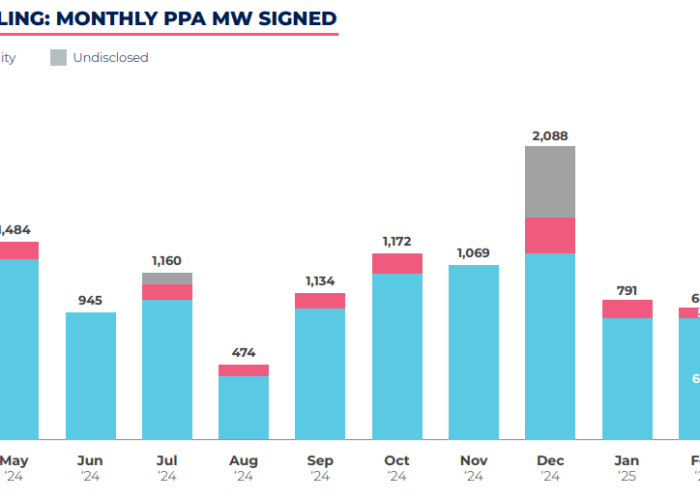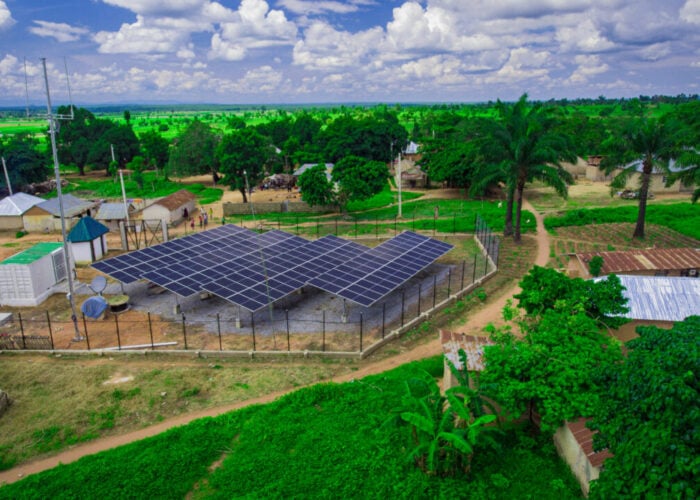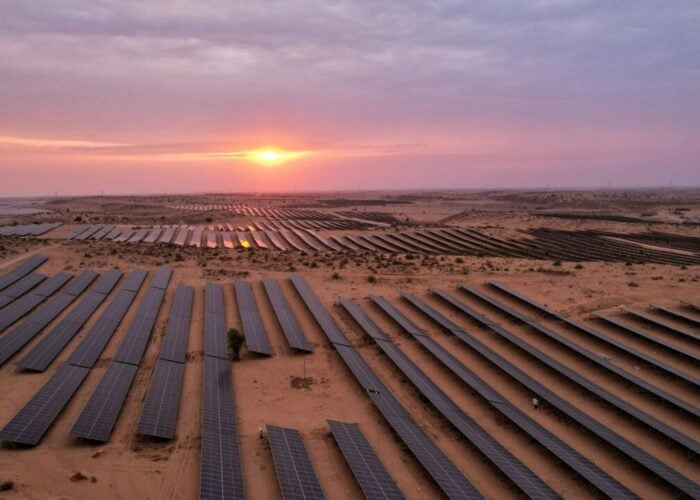
“We as an industry have to be more active in politics,” says Jon Powers, president of US renewable energy investment firm CleanCapital. “The policy is made, but it’s made in support of politics. So we have to be out there supporting members – bipartisan – who support our issues.”
PV Tech Premium sat down with Powers at the RE+ trade show in Anaheim, California, earlier this month. In a white and echoing plasterboard booth erected somewhere in the bowels of the Anaheim Convention Centre, he gave us his view on the big-picture issues facing the US solar industry today. How does it keep the ball rolling on the Inflation Reduction Act (IRA)? Is domestic energy security more important than a fast energy transition? And how does the presidential election impact solar project financing?
Unlock unlimited access for 12 whole months of distinctive global analysis
Photovoltaics International is now included.
- Regular insight and analysis of the industry’s biggest developments
- In-depth interviews with the industry’s leading figures
- Unlimited digital access to the PV Tech Power journal catalogue
- Unlimited digital access to the Photovoltaics International journal catalogue
- Access to more than 1,000 technical papers
- Discounts on Solar Media’s portfolio of events, in-person and virtual
Or continue reading this article for free
However, his resounding point—“a personal mission this year”—was to insist that the solar industry needs to grow up.
“You’re seeing the industry step up with new PACs (political action committees) and donors. There are groups like Clean Energy for America that are actively representing the workforce and advocating for that. That’s new for our industry,” he says, pausing for thought.
Formerly the Federal chief sustainability officer in the Obama administration and a US army veteran, it’s fair to say that Powers is well versed in the importance of politics.
“[In 2020, the last election cycle] we had just got started,” he says. “Now, we are a much more politically active industry – and we should be. We’re no longer an alternative industry, we are soon to be the mainstream energy industry in the US. We’ve grown up a lot, and my hope is that we continue that trend because it’s not just about November [elections], it’s about putting in place the broader infrastructure to grow.”
He points out that the oil and gas industries have been lobbying politicians “for decades…now we have to do it in a new way in our industry.” Indeed, Amnesty International found that a “record number” of oil lobbyists attended the COP28 conference last year, which complicates the event’s official purpose.
The Solar Energy Industries Association (SEIA), America’s chief industry body, runs the SolarPAC, which it says “allows the solar industry to support federal candidates…who will promote a legislative and regulatory climate favourable to our industry”. A number of other companies and bodies in the clean energy industries have also launched PACs.
IRA brings certainty
While he said the industry should be more aggressively political, Powers wasn’t short of praise for the current state of US policy and the IRA’s impact on his industry. As an investor first and foremost, CleanCapital prizes certainty. For Powers, the IRA, in tandem with the Bipartisan Infrastructure Law (BIL) designed to shore up, revamp and expand the US grid, provides that.
“The nice thing about the IRA and the BIL and how they work together is that a public investment here in the US is going to catalyse a tremendous amount of private investment,” he says.
In 2010, policy alignment in the US “really got solar moving”, he says, through a growing supply chain, falling panel prices and a growing workforce, which improved the cost of capital and brought private investment to the industry. This is happening today, too, but to a previously unrecognisable extent.
By Powers’ estimate, this time around “It’s not that ‘we need to create this industry’, it’s ‘how do we actually streamline things and do it better?’
“[The tax credits and investments in the IRA/BIL] provided more and more certainty, and with that certainty, you get better capital, right? Uncertainty is a risk, risk means higher [cost of] capital. With more certainty, the infrastructure investors and others can deploy more and more.”
Nonetheless, things still need ironing out. Powers says there are some “weird things” in the IRA, like the way grants are awarded for brownfield developments:
“Some of that stuff has to be better aligned. And then I think the domestic content piece is really important,” he says. “Literally, quarter by quarter you’re seeing new manufacturing created here in the US.”
Manufacturers have said that the domestic content bonus, which adds a 10% tax credit for a project which meets the 45% cost-based threshold of US-made products outlined in the legislation, needs clarifying and reforming to meet its potential. The Solar Energy Manufacturers for America (SEMA) coalition has publicly called for the bonus to be amended to recognise domestically produced silicon wafers in its calculations to stimulate domestic demand, and our coverage of the RE+ show heard that some are calling for an increase in the incentive for developers.
Energy security for solar?
Beyond concerns over the domestic content procedures, PV Tech Premium has recently noted a rift in US solar between manufacturers and developers over where the nation’s priorities (as embodied by the IRA) should lie, as solar emerges as the leading technology in the US energy transition.
The concentration of solar supply in China and Southeast Asia poses energy security risks for the rest of the world (the US included) if any geopolitical or supply issues arise, but it has also facilitated the explosion in solar generation capacity over recent years.
Trade defences (led by the US) are increasingly being used to incentivise and support manufacturing operations in domestic markets, but they have the potential to create shortages in supply and significantly impact the economics of developing solar projects.
So, does the US need more trade defences to ensure its energy security?
Powers laughs. “It’s a good question. I would flip the framework and say that we need a continued offence on why we should be building things like manufacturing here in the US in this next generation of a new economy. Those are the things that are more important to me than a tariff defence.”
This is similar to the arguments espoused by the SEIA, which emphasises incentives rather than restrictions. However, US solar has not been immune to a wider shift away from globalisation and towards isolationism and the logistical and intellectual snags that this entails.
Powers was hesitant to say whether he sees a clear priority between solar deployments and domestic manufacturing security.
“The tax credit piece [of the IRA] really starts hitting in 2025, so I think we’ll start to see more then. I think it’s important for our industry that we continue to grow the manufacturing base and I think you’re going to see more and more support there. I think there was a realisation when they passed the bill it was going to take some time. It’s just taking longer.”
Community awareness of the benefits of manufacturing will be important, he says, adding that there are “so many” industrial towns in the US which could be brought onboard to a manufacturing buildout.
“If we can build out communities that have a clean energy economy that’s not just about panels, it’s about manufacturing, I think that’s very important. And every manufacturing job creates something like four other jobs; it’s just helping rebuild an industrial base here, which I think is very important from a security perspective. I’m less concerned about the actual panels themselves.”
There remains a question over whether the broader market forces will allow domestic manufacturing to take root in the US. Massive oversupply and falling prices have taken their toll on a number of companies looking to go beyond module assembly in the US, despite the incentives of the IRA. Currently, modules themselves are on track to fulfil a significant portion of US solar demand by the end of the decade, but most of these will likely be made with imported products made by Chinese-owned or affiliated companies; some would say this undermines rhetoric around the importance of the US’ domestic energy security.
‘Bringing efficiencies to the industry’
Solar modules have never been more abundant. They have also rarely been as scrutinised for their quality and technology offering, as prices have fallen and the industry at large has transitioned from p-type to n-type products.
Within this market backdrop, Powers says that both quality concerns and technology shifts have changed how CleanCapital operates.
“The institutional technology, the foundation of what we’re doing, is there. But what we’re seeing now is so much climate tech investment which will continue to bring efficiencies into our industry. Whether it be new trackers to new ways to install them to drones that fly over [a plant] to make sure you’re getting the best output.”
Module efficiency advancements have enabled the company to build four PV plants in Alaska, one of the most northerly latitudes where PV is likely to be deployed.
“That’s because the industry has got to a point where we can have bifacial modules and make the most of every ray that reaches us. And Alaska is in dire need of things like solar because they’re running out of natural gas. They wouldn’t have been able to do that a decade ago, but because of bifacial modules we can start making those improvements.”
He says the company also pays attention to module quality. This is because it’s structured as a long-term owner, rather than a series of funds which will buy and sell projects before they reach the end of their lifespans.
Following a November 2023 report from Clean Energy Associates that found a “massive increase” in solar module defects deployed in the US, analyses from a number of institutions and technology certification firms have found technical defects and issues with the new generation of n-type solar technology. Simultaneously, the massive expansion of solar PV manufacturing capacity and the concurrent drop in average module selling price have led to concerns over possible cost-cutting measures which manufacturers could employ, which might have knock-on effects on module quality.
Powers says CleanCapital is “structured as a long-term owner, so that really forces us to think of quality. Our construction team thinks of it regularly, as does our asset management team; we don’t just build a project and forget about it, we are getting feedback from asset management about what’s working and what’s not.”
Election forecast
Most people that PV Tech has spoken with in the solar industry have been fairly sanguine about the upcoming election. The overall sentiment is that the energy transition has the momentum to weather a possible change in executive direction in Washington and much of the IRA is not going to be repealed.
However, Powers foresees some uncertainties which will have impacts for project financing: “There’s a stark policy contrast between the two presidential candidates. To me, that’s really what matters,” he says.
“The Harris administration has been pretty clear about continuing many of the Biden policies that have given that policy certainty which has allowed us to continue to scale. I believe in a Trump administration there will be a lot of uncertainty, whether it be his efforts to take pieces of the IRA or some of the trade issues, etc.
“We will continue to do well as an industry regardless; the trends are very clear. But there’s no doubt about it: that uncertainty will cause risk which will mean a higher cost of capital.”






